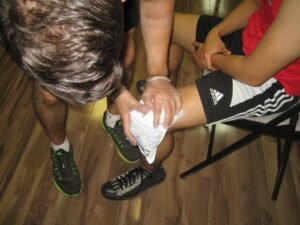A medial ligament sprain involves a tear on the ligament on the interior of the knee, usually from twisting forces or direct impact. The injuries are common in contact sports such as rugby and football as well as in martial arts. An injury can occur from falls or twisting of the joint.
Indications of a medial ligament sprain
Grade 1
- Less than 10% of the fibers are torn
- Minor tenderness on the interior of the knee over the ligament
- There is no swelling
- If the knee is bent 30 degrees and an outward force is placed on the lower leg to stress the medial ligament, pain is produced but there is no laxity of the joint (valgus stress test)
Apply an ice pack for 10-15 minutes every hour. The frequency is reduced as the symptoms start to settle.
Grade 2
- Significant tenderness can be felt on the interior of the knee along the medial ligament
- Minimal swelling is present over the ligament
- If the valgus stress test is applied, pain is produced with mild to moderate laxity in the joint but the knee could not be bent sideways completely
Grade 3
- Full tear of the medial ligament
- Pain tends to vary and not as intense as a grade 2 sprain
- The valgus stress test indicates evident joint laxity
- Knee feels wobbly or unstable
Management for a medial ligament sprain
Initial treatment
- Utilize the PRICE method (protection, rest, ice, compression, elevation) as part of the initial care for a medial ligament sprain
- The individual should rest from training or any activities that trigger pain to allow healing to start
- Apply an ice pack for 10-15 minutes every hour. The frequency is reduced as the symptoms start to settle.
- Use a compression bandage or support for the knee to minimize any inflammation and protect the joint.
Using a hinged knee brace
This is a sturdy knee support built with compact metal supports at the sides to avert sideways motion as well as protecting the knee ligaments as they heal.
Taping
Taping of the joint can provide support and protection. This is usually done in the initial phases as well as later when returning to training.
Electrotherapy
Ultrasound treatment involves the use of high frequency sound waves that are applied on the damaged tissues. This treatment is used in the early acute stages to reduce the pain and swelling.
Exercise
A rehabilitation program that includes strengthening and mobility exercise must be started as soon as the individual is free from pain.
More Information / Disclaimer
The information posted on this page on a medial ligament sprain is for learning purposes only. Learn to recognize and manage ligament injuries by taking a standard first aid course with one of our training providers.

